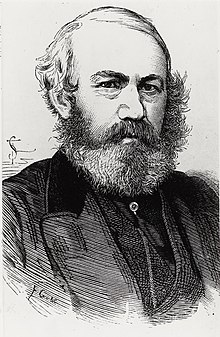Thomas Bouch
Sir Thomas Bouch (born February 25, 1822 in Thursby , † October 30, 1880 in Moffat , Scotland ) was known as the engineer of the Firth-of-Tay Bridge , for whose construction he was knighted .
Life
His father was an employee in a trading company. His son Thomas first got his education in the local Thursby before he spent a few years at a private school in nearby Carlisle. At the age of 17 he decided to work as a technical designer by starting an apprenticeship with the two engineers Lomar and Errington . These two designers worked for the Lancaster and Carlisle Railway , which had a branch in Carlisle. By the time he completed his apprenticeship, Bouch was so competent that he could immediately take over the management of a construction team. The time of his activity was at a time of undreamt-of construction activity on railway lines, which he spent mainly on smaller routes in northern England. In 1840 he was busy building the Weardale Railway , then he became chief designer of the Edinburgh, Perth, and Dundee line .
The mouths of Forth and Tay represented an interruption to the continuous rail traffic. All luggage had to be time-consuming from the railroad to a steamer and then reloaded again. Here Bouch saw an immediate opportunity for improvement. After many difficulties, he solved the task with the help of a hydraulic hanging scaffold. So it was now possible to load the railroad cars on board the steamer. His idea was soon adopted and was the basis for similar procedures around the world.

Bouch is now leaving the North British Railway Company to do business on his own account with his knowledge and reputation in the railway industry. Here it was particularly successful: the meanwhile better traction of the locomotives made it possible to build tighter curve radii, so that fewer engineering structures such as tunnels or bridges were required, which were particularly responsible for the high costs of railway construction. The implementation of these plans brought him considerable profit.
In addition, Bouch worked very intensively on the construction of elegant, light bridges. Many of the structures proved its success. Construction drawings for viaducts at the mouths of the Forth and Tay were soon available, which he classified under the heading of “unrealized possibility”, as one could do without the loading of the railroad car. This construction was to become his fate, if one broke new ground with it in many respects: the length alone, but also the weather effects of wind and ocean currents, were new challenges. The plans were changed several times, but finally the bridge was inaugurated in 1877 with great participation by the population.
The structure withstood the forces of nature for a year and a half until the railway accident on the Firth-of-Tay-Bridge occurred in a severe storm . The middle part crashed into the sea with a moving train, all 75 occupants died. Bouch did not recover from this tragedy, he died within a year after the accident.
Works
In addition to the construction of numerous railway lines, the invention of RO-RO ferries and many other optimizations in the railway industry, bridge constructions are primarily due to him:
- Hownes Gill Viaduct (1858)
- Newcastle Bridge (1871)
- Redheugh Bridge (1870)
- Tay Bridge, Firth of (1877)
The planning of the Forth Bridge is also part of his legacy, even if construction work was withdrawn from him after the Tay Bridge collapsed.
Web links
- Detailed, also further texts (English)
- Much background information (English)
- Thomas Bouch. In: Structurae
Individual evidence
| personal data | |
|---|---|
| SURNAME | Bouch, Thomas |
| BRIEF DESCRIPTION | English engineer |
| DATE OF BIRTH | February 25, 1822 |
| PLACE OF BIRTH | Thursby |
| DATE OF DEATH | October 30, 1880 |
| Place of death | Moffat (Dumfries and Galloway) , Scotland |
